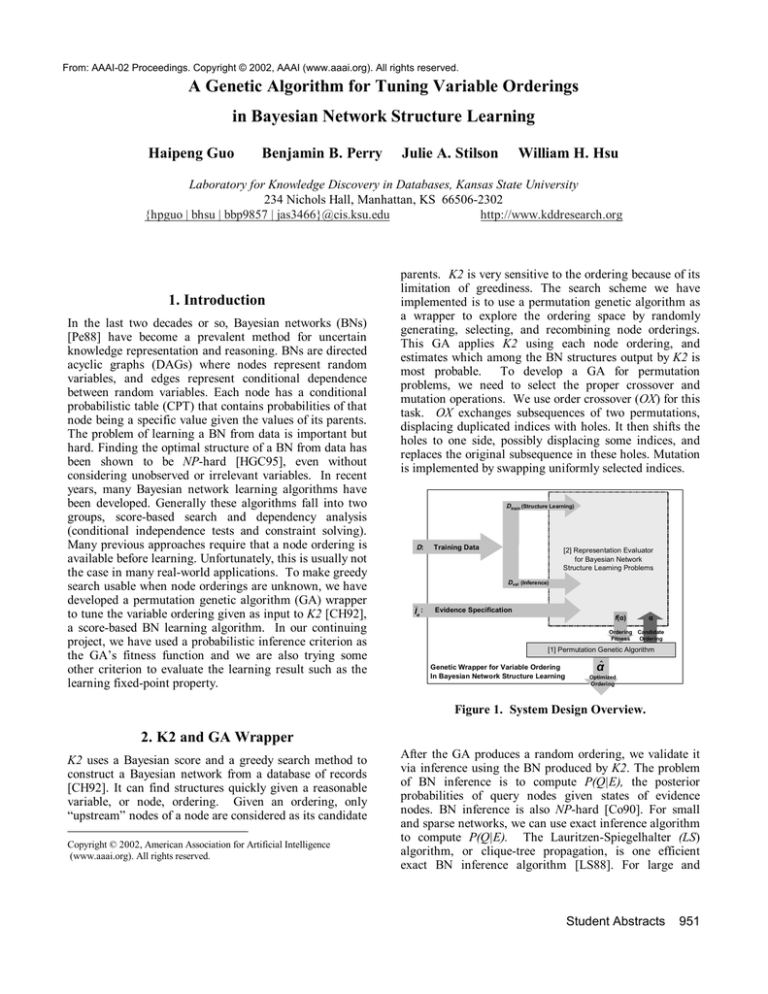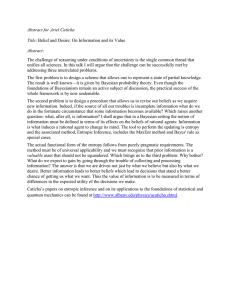
From: AAAI-02 Proceedings. Copyright © 2002, AAAI (www.aaai.org). All rights reserved.
A Genetic Algorithm for Tuning Variable Orderings
in Bayesian Network Structure Learning
Haipeng Guo
Benjamin B. Perry
Julie A. Stilson
William H. Hsu
Laboratory for Knowledge Discovery in Databases, Kansas State University
234 Nichols Hall, Manhattan, KS 66506-2302
http://www.kddresearch.org
{hpguo | bhsu | bbp9857 | jas3466}@cis.ksu.edu
1. Introduction
In the last two decades or so, Bayesian networks (BNs)
[Pe88] have become a prevalent method for uncertain
knowledge representation and reasoning. BNs are directed
acyclic graphs (DAGs) where nodes represent random
variables, and edges represent conditional dependence
between random variables. Each node has a conditional
probabilistic table (CPT) that contains probabilities of that
node being a specific value given the values of its parents.
The problem of learning a BN from data is important but
hard. Finding the optimal structure of a BN from data has
been shown to be NP-hard [HGC95], even without
considering unobserved or irrelevant variables. In recent
years, many Bayesian network learning algorithms have
been developed. Generally these algorithms fall into two
groups, score-based search and dependency analysis
(conditional independence tests and constraint solving).
Many previous approaches require that a node ordering is
available before learning. Unfortunately, this is usually not
the case in many real-world applications. To make greedy
search usable when node orderings are unknown, we have
developed a permutation genetic algorithm (GA) wrapper
to tune the variable ordering given as input to K2 [CH92],
a score-based BN learning algorithm. In our continuing
project, we have used a probabilistic inference criterion as
the GA’s fitness function and we are also trying some
other criterion to evaluate the learning result such as the
learning fixed-point property.
parents. K2 is very sensitive to the ordering because of its
limitation of greediness. The search scheme we have
implemented is to use a permutation genetic algorithm as
a wrapper to explore the ordering space by randomly
generating, selecting, and recombining node orderings.
This GA applies K2 using each node ordering, and
estimates which among the BN structures output by K2 is
most probable. To develop a GA for permutation
problems, we need to select the proper crossover and
mutation operations. We use order crossover (OX) for this
task. OX exchanges subsequences of two permutations,
displacing duplicated indices with holes. It then shifts the
holes to one side, possibly displacing some indices, and
replaces the original subsequence in these holes. Mutation
is implemented by swapping uniformly selected indices.
Dtrain (Structure Learning)
D:
Training Data
[2] Representation Evaluator
for Bayesian Network
Structure Learning Problems
Dval (Inference)
ÿ
Ie :
Evidence Specification
f(ÿ)
ÿ
Ordering Candidate
Fitness
Ordering
[1] Permutation Genetic Algorithm
Genetic Wrapper for Variable Ordering
In Bayesian Network Structure Learning
ÿ̂
Optimized
Ordering
Figure 1. System Design Overview.
2. K2 and GA Wrapper
K2 uses a Bayesian score and a greedy search method to
construct a Bayesian network from a database of records
[CH92]. It can find structures quickly given a reasonable
variable, or node, ordering. Given an ordering, only
“upstream” nodes of a node are considered as its candidate
Copyright © 2002, American Association for Artificial Intelligence
(www.aaai.org). All rights reserved.
After the GA produces a random ordering, we validate it
via inference using the BN produced by K2. The problem
of BN inference is to compute P(Q|E), the posterior
probabilities of query nodes given states of evidence
nodes. BN inference is also NP-hard [Co90]. For small
and sparse networks, we can use exact inference algorithm
to compute P(Q|E). The Lauritzen-Spiegelhalter (LS)
algorithm, or clique-tree propagation, is one efficient
exact BN inference algorithm [LS88]. For large and
Student Abstracts
951
Dtrain (Structure Learning)
be many models that explain the data reasonably well”.
This makes us less confident about that the learned model
is a true representation to the underlying process. To
improve confidence we are considering sample complexity
issues in the learning process. We are also trying to use
the fixed-point property of the learning process as a fitness
function to evaluate the learned model. Our conjecture is
that a good initial model shall converge in probability to a
fixed point under a learning and stochastic data generation
process while a bad model shall not. Our preliminary
result shows that this may be a promising direction in the
future.
[A] Greedy Score-Based
Structure Learning Algorithm
(K2)
and Parameter Estimation
Algorithm
B = (V, E, Θ)
Learned Bayesian Network
Dval (Inference)
ÿ
Ie : Evidence Specification
[B] Probabilistic
Inference
Algorithm
(Exact or
Approximation
by Sampling)
[2] Representation Evaluator
for Bayesian Network
Structure Learning Problems
f(ÿ)
ÿ
Ordering Fitness
(Inferential Loss: MSE)
Candidate Ordering
(Permutation)
Figure 2. Probabilistic reasoning environment,
Module [2] from Figure 1.
complex BNs, we apply approximate inference. Stochastic
simulation algorithms are the most often used
approximate inference methods, which include logic
sampling, likelihood weighting, backward sampling, selfimportance sampling, and adaptive importance sampling
(AIS). We divide the input data into training data Dtrain
and validation data Dval. Dtrain is used to learn the BN and
Dval is used to validate the learned BN. We first compute
P(Q|E) from Dval, and P’(Q|E) from the BN produced by
K2, using either LS or AIS. We then compute a loss
function (RMSE) between P(Q|E) and P’(Q|E), and use it
as the GA’s fitness function. Figure 1 shows the system
overview.
3. Result & Discussion
System components implemented so far include K2 for
learning BNs, the LS algorithm and several stochastic
sampling algorithms for inference, and the GA wrapper
for tuning the node ordering. We implemented an elitist
permutation GA using OX. Our initial experiments were
conducted on an eight nodes BN whose permutation space
contains 8! = 40320 different orderings. The result shows
the GA (10 populations, 100 generations) improves the
ordering to within 0.01 of the optimal RMSE (about 0.95
calculated by LS algorithm on the standard BN). Our work
is closely related to [LPYM+96] in which they also
applied a GA to Bayesian network learning. But they only
focused on structure learning. They used the same
Bayesian score as K2 to evaluate a learned network
structure and they used GA to directly operate on the
network structure itself. Our scheme uses a different
fitness function and the GA operates on a smaller space,
i.e., the variables ordering space. Although our initial
result is promising, we feel that it could be further
improved by trying better fitness functions for the GA
wrapper. The problem we need to overcome is the same as
discussed in [NK00]: “In case where the amount of data is
small relative to the size of the model, there are likely to
952
Student Abstracts
Acknowledgements
Support for this research was provided in part by the
Army Research Lab under grant ARL-PET-IMT-KSU-07
and by the Office of Naval Research under grant N0001401-1-0519.
References
[CD00] J. Cheng and M. J. Druzdzel. AIS-BN: An
adaptive importance sampling algorithm for evidential
reasoning in large Bayesian networks. Journal of
Artificial Intelligence Research (JAIR), 13:155-188, 2000.
[CH92] G. F. Cooper and E. Herskovits. A Bayesian
Method for the Induction of Probabilistic Networks from
Data. Machine Learning, 9(4):309-347, 1992.
[Co90] G. F. Cooper. The computational complexity of
probabilistic infernece using bayesian belief networks.
Artificial Intelligence, 42(2-3):393-405. Elsevier, 1990.
[HGC95] D. Heckerman, D. Geiger, and D. Chickering,
Learning Bayesian networks: The combination of
knowledge and statistical data. Machine Learning,
20(3):197-243, Kluwer, 1995.
[LPYM+96] P. Larranaga, M. Poza, Y. Yurramendi, R. H.
Murga and C.M.H. Kuijpers. Structure Learning of
Bayesian Networks by Genetic Algorithms: A
Performance Analysis of Control Parameters. IEEE
Journal on Pattern Analysis and Machine Intelligence
18(9): 912-926, 1996.
[LS88] S. L. Lauritzen and D. J. Spiegelhalter. Local
computations with probabilities on graphical structures
and their application to expert systems. Journal of the
Royal Statistical Society, Series B 50, 1988.
[NK00] N. Friedman and D. Koller. Being Bayesian
About Network Structure: A Bayesian Approach to
Structure Discovery in Bayesian Networks. In UAI00.
[Pe88] J. Pearl. Probabilistic Reasoning in Intelligent
Systems: Networks of Plausible Inference, Morgan
Kaufmann, San Mateo, CA, 1988.






